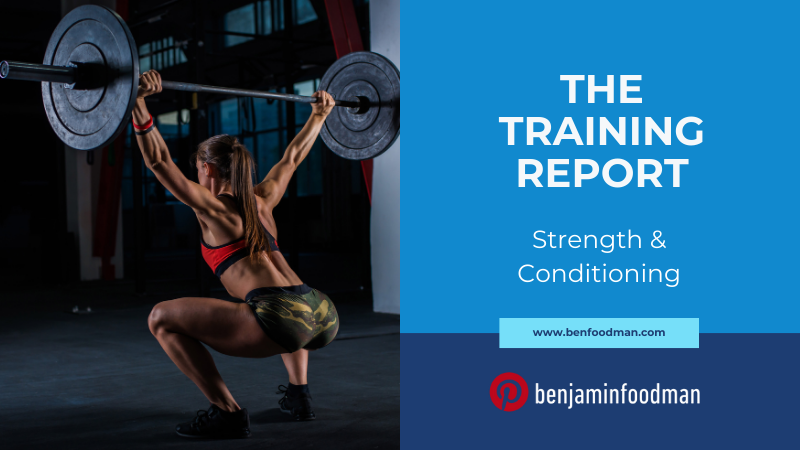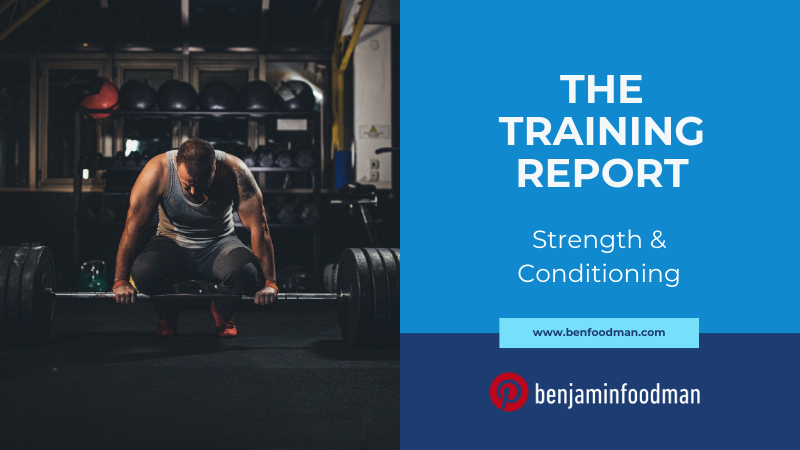Strength & Conditioning - Exercise Science Periodization Strategies Part I. Endurance Athletes
About the Author
Ben Foodman is a licensed psychotherapist & performance specialist. He owns his private practice located in Charlotte North Carolina where he specializes in working with athletes to help them overcome mental blocks (the yips), PTSD, ADD / ADHD and achieve flow states through the techniques of Brainspotting & Neurofeedback. If you are interested in services, use the link here! Enjoy the article below!
Introduction: Endurance Athletes And Strength & Conditioning Strategies
There are many critics that will make statements that running and endurance-focused sports are not ‘real’ sports. However these critics could not be further from the truth and only expose their ignorance about the complexities behind endurance athlete training. Performers operating in the endurance athlete space have to make difficult tactical decisions (e.g., creating time controlled plans for energy expenditure) and intricate long-term training plans that will help them properly peak for endurance sport events such as marathons, ultramarathons and triathlons.
Because there is so much interest in the science behind endurance athlete training, I wanted to provide a glimpse into the exercise science principles that guide the periodization strategies for this sport population. First I will review the definition of endurance training and how endurance athletes can benefit from certain types of strength training. Next I will review the benefits of focusing on heart rate zone training, and finally I will provide Target Heart Rate Calculations endurance athletes can use to enhance their training. Let’s first begin by defining endurance.
Part I. Defining Endurance Training & How Athletes Can Enhance Performance Through Strength Training
In the book Periodization, Theory And Methodology Of Training 4th Edition by Dr. Tudor Bompa, the author provides the following definition for endurance training: Endurance refers to the length of time that an individual can perform work of a given intensity. The main factor that limits and at the same time affects performance is fatigue. A person has endurance when he or she does not easily fatigue or can continue work in a stage of fatigue An athlete is capable of doing this if he or she is adapted to the specifics of the work performed. Endurance depends on many factors, such as speed, muscle force, technical abilities of performing movements efficiently, the ability to use physiological potentials economically, and psychological status when performing work. There is no way to thoroughly cover all aspects of endurance training and all of the different approaches that go into achieving peak performance outcomes, but two underutilized methodologies that endurance athletes seem to avoid is cross-training and weight training. Cross-training is a mode of training that can be used to maintain general conditioning in athletes during periods of reduced training due to injury or during recovery from a training cycle. Cross-training may reduce the likelihood of overuse injuries because it distributes the physical stress of training to muscle groups different from those used during training. This is where resistance training/weightlifting come into play.
Many endurance athletes are under the impression that by weightlifting and adding muscle this will negatively impact their endurance performance outcomes. This could not be further from the truth. While it is true that athletes involved in power-based sports (e.g., Olympic weightlifting, baseball) will lose their explosiveness when engaged in endurance training, endurance athletes will not lose their endurance performance outcomes when using weightlifting/strength-based exercises in their programming. Per the National Strength & Conditioning Association’s Essentials of Strength Training & Conditioning 4th Edition: Resistance training is an important but often overlooked factor in improving performance in aerobic endurance athletes. Overall, research on the effects of resistance training on performance in trained aerobic endurance athletes is limited; however, some data suggest that benefits can be derived from performing resistance training during aerobic endurance training. Of particular importance, Hickson and colleagues demonstrated that although the VO2 max of highly trained aerobic athletes did not improve as a result of resistance training, there was an improvement in short-term exercise performance during both cycling and running. Benefits that aerobic endurance athletes may obtain from performing resistance training include faster recovery from injuries, prevention of overuse injuries, and reduction of muscle imbalances.
Part II. Endurance Athletes & Heart Rate Training
My main area of focus is sport psychology, but as a Certified Strength & Conditioning Specialist (CSCS) I am always still blown away by how many endurance coaches avoid placing an emphasis on Heart Rate Zone training. Most of the endurance athletes and coaches I have worked with place a heavy emphasis on their pace as it relates to the time it takes them to perform an endurance task. But the fundamental, evidence-based strategies that exercise science experts use to construct their programming is focusing on Heart Rate Zone training. Per the NSCA: Heart rate is likely the most frequently used method for prescribing aerobic exercise intensity. The reason is the close relationship between heart rate and oxygen consumption, especially when the intensity is between 50% and 90% of functional capacity (VO2 Max), also called heart rate reserve (HRR), which is the difference between an athlete’s maximal heart rate and his or her resting heart rate. The most accurate means of regulating intensity using this method is to determine the specific heart rate associated with the desired percentage of VO2 max or the heart rate associated with the lactate threshold.
The authors of the NSCA essentials guide continue: For the greatest precision, this necessitates laboratory testing to identify these exercise intensities. If laboratory testing is unavailable, then the individual’s age-predicted (estimated) maximal heart rate (APMHR) can be used as the basis for determining exercise intensity. Refer to the below table TARGET HEART RATE CALCULATIONS for formulas and sample calculations for determining aerobic endurance exercise heart rate ranges using the Karvonen Method and the Percentage of Maximal Heart Rate (MHR) method. Although the Karvonen and percentage of maximal heart rate formulas provide practical intensity assignments, basing them on age-predicted maximal heart rates may entail some inaccuracies (vs. laboratory-tested maximal heart rates) when exercise intensity is being monitored during cycling or running. It has been determined that age contributes 75% of the variability of heart rate, the effects of other factors such as mode of exercise and fitness level must also be considered with the use of hear rate to monitor intensity. Now that we have reviewed key considerations associated with heart rate training, let’s review the formulas that athletes can use in their training methodology.
Part III. Target Heart Rate Calculations For Endurance Athlete Periodization Strategies
Karvonen Method
Formula:
Age predicted maximum heart rate (APMHR) = 220 - age
Heart rate reserve (HRR) = APMHR - resting heart rate (RHR)
Target heart rate (THR) = (HRR X exercise intensity) + RHR
Do this calculation twice to determine the target heart rate range (THRR).
EXAMPLE: A 30-year old athlete with an RHR of 60 beats/min is assigned an exercise intensity of 60% to 70% of functional capacity:
APMHR = 220 - 30 = 190 beats/min
RHR = 60 beats/min
HRR = 190 - 60 = 130 beats/min
Lowest number of the athlete’s THRR = (130 x 0.60) + 60 = 78 + 60 = 151 beats/min
When monitoring heart rate during exercise, divide the THRR by 6 to yield the athlete’s THRR in number of beats for a 10 second interval:
138/6 = 23 & 151/6 = 25
The athlete’s THRR is 23 to 25 beats per 10 seconds
Percentage Of Maximal Heart Rate Method
Formula:
Age-predicted maximum heart rate (APMHR) = 220 - age
Target heart rate (THR) = (APMHR x exercise intensity)
Do this calculation twice to determine the target heart rate range (THRR).
EXAMPLE: A 20-year old athlete is assigned an exercise intensity of 70% to 85% of maximal heart rate:
APMHR = 220 - 20 = 200 beats/min
Lowest number of the athlete’s THRR = 200 x 0.70 = 140 beats/min
Highest number of the athletes’ THRR = 200 x 0.85 = 170 beats/min
When monitoring heart rate during exercise divide the THRR by 6 to yield the athlete’s THRR in number of beats for a 10 second interval:
140/6 = 23 & 170/6 = 28
The athlete’s THRR is 23 to 28 beats per 10 seconds
Note To Reader:
If you are an athlete reading this segment of the TRAINING REPORT, hopefully this content was helpful! I put the Training Report together because I felt like many of the discussions on issues such as the Yips/mental blocks, strength training & other subject matter on athlete performance concepts were really missing the mark on these ideas (e.g. how trauma is the direct cause of the Yips). If you are interested in learning more, make sure to subscribe below for when I put out new content on issues related to sport psychology & athlete performance! Also, if you are looking to work with a mental performance specialist, you are in the right place! USE THIS LINK to reach out to me to see if my services are the right fit for your goals!
ARE YOU ON THE LIST?
Make sure you’re signed up to Ben’s mailing list which will be emailed directly to your inbox. Don’t wait, sign up now!


























